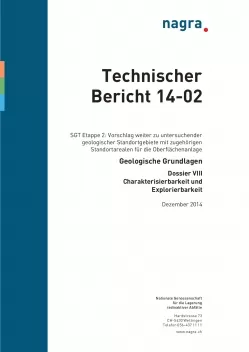
Technischer Bericht NTB 14-02/VIII
SGT Etappe 2: Vorschlag weiter zu untersuchender geologischer Standortgebiete mit zugehörigen Standortarealen für die OberflächenanlageGeologische GrundlagenDossier VIII:Charakterisierbarkeit und Explorierbarkeit
Dossier VIII: Ease of characterisation and explorability
Dossier VIII on 'ease of characterisation and explorability' describes the background information used to evaluate three indicators for the safety-based comparison of Stage 2 of the Sectoral Plan process: 'variability of rock properties with respect to their ease of characterisation', 'exploration conditions underground' and 'exploration conditions at the surface'.
Chapter 2 discusses the 'variability of host rock properties with respect to their ease of characterisation'. As part of a safety-oriented approach, it is checked for the individual host rocks whether preferential flowpaths with unfavourable radionuclide retention properties could occur that cannot be located or characterised reliably. The occurrence of such flowpaths depends on the interaction of a range of different lithofacies units with tectonic-structural elements. Preferential flowpaths can also occur along tectonic-structural elements with very slight displacements in lithofacies units that have a reduced self-sealing capacity. These elements cannot be identified using seismic methods and, because of their usually complex internal structure, they cannot be characterised hydraulically with any degree of reliability using boreholes. In lithofacies units with a reduced self-sealing capacity, it therefore has to be expected that such safety-relevant elements can occur, but that they cannot be located or characterised reliably. In rocks with a high self-sealing capacity, no preferential flowpaths with unfavourable radionuclide retention properties are expected.
The Opalinus Clay has very good self-sealing properties and the potential for undetected preferential flowpaths is therefore very low. The 'Brauner Dogger' has good self-sealing properties only in its upper half. In the remaining part there are metre-thick intercalations (hard banks) with partly very low clay mineral contents that cannot be correlated laterally sufficiently well and lie below the seismic resolution capacity. The potential for undetected preferential flowpaths is therefore increased over the entire 'Brauner Dogger'. The Effingen Member consists of alternating calcareous marl sequences with an average self-sealing capacity and limestone sequences with a poor self-sealing capacity. Correlation of the sequences between boreholes is possible to some extent, but there are uncertainties. The potential for undetected preferential flowpaths in the Effingen Member is therefore considerable because it has at best an average self-sealing capacity. The Helvetic Marls consist to a large extent of sheared marls with an average self-sealing capacity. Intercalations of limestone sequences are difficult to correlate and limestone wedges with large dimensions can occur as tectonic inclusions of foreign rock. The potential for undetected preferential flowpaths in Helvetic Marls, particularly along fault zones, is therefore higher than in other siting regions.
Chapter 3 considers the 'exploration conditions underground'. Important in this respect is the possibility of exploration using 3D seismic methods. The ability to investigate using 3D seismics is the most important criterion for achieving a spatially comprehensive analysis of the structural situation underground. The host rocks being considered in Northern Switzerland – Opalinus Clay, 'Brauner Dogger' and the Effingen Member – lie regionally in a highly reflective layer stack that can be imaged reliably using seismic methods. The Opalinus Clay has a good vertical and lateral continuity and safety-relevant displacements can thus be detected reliably. In the 'Brauner Dogger', investigations in outcrops and boreholes have shown lateral lithological changes that cannot be detected reliably using seismic methods. The internal structure of the Effingen Member has a sufficient lateral continuity, as has been demonstrated by log correlations from several boreholes. However, as the calcareous marl sequences and limestone sequences have a restricted self-sealing capacity, small tectonic displacements which cannot be located using seismic methods could result in formation of preferential flowpaths. The Helvetic Marls in the Wellenberg siting region show only small impedance contrasts with the surrounding rock; added to this is the fact that the host rock boundaries are steeply dipping. The requirements for seismic investigation of the host rock and any faults present are therefore not fulfilled in this case.
For the site-specific evaluation of exploration conditions underground, the host rocks that come into question are considered individually. The underground spatial conditions in the siting regions show good explorability for all the host rocks. In the areas where they are considered as host rocks, the Opalinus Clay and the 'Brauner Dogger' are embedded in a sequence of reflective layers, which allows reliable imaging of the tectonic situation. Differences between the individual siting regions are the result of the local geological situation. The geometry of the Effingen Member in the eastern part of the Jura-Südfuss siting region can be interpreted using local auxiliary horizons. The underground in the Wellenberg siting region cannot be investigated meaningfully using 3D seismics. Here, investigations have to rely completely on boreholes or even exploratory drifts.
Chapter 4 presents the basic requirements for the 'exploration conditions at the surface' in terms of being able to use high-resolution 3D seismics over large areas. Detailed studies were carried out on the measurement effort required and the risk of insufficient seismic fold for provisionally defined seismic perimeters for the geological siting regions in Northern Switzerland when exploring the primary host rock. A reliable explorability from the surface exists in all the siting regions. There are slight differences for the individual regions or parts of them, depending on surface conditions such as population density, river courses or infrastructure. The exploration conditions at the surface for borehole investigations are good for all the siting regions in Northern Switzerland given the small dimensions of the drillsites and the existing flexibility regarding their location.
